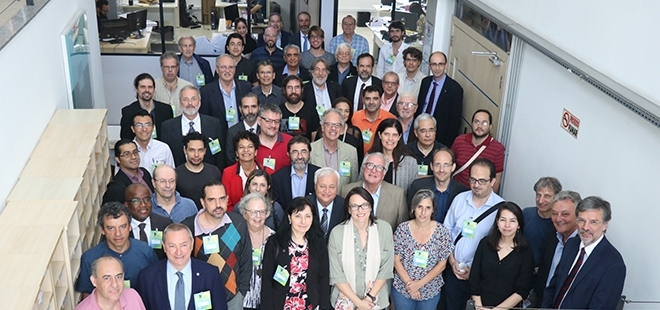

Researchers and heads of funding agencies from several countries highlight ways and means of fostering large-scale long-term scientific collaborations in Latin America (photo: Felipe Maeda / Agência FAPESP)
Researchers and heads of funding agencies from several countries highlight ways and means of fostering large-scale long-term scientific collaborations in Latin America.
Researchers and heads of funding agencies from several countries highlight ways and means of fostering large-scale long-term scientific collaborations in Latin America.

Researchers and heads of funding agencies from several countries highlight ways and means of fostering large-scale long-term scientific collaborations in Latin America (photo: Felipe Maeda / Agência FAPESP)
By Maria Fernanda Ziegler | Agência FAPESP – Long-term scientific collaborations require large-scale research infrastructure. A good example of this is Europe’s Large Hadron Collider (LHC). Considered the world’s largest machine, the LHC’s construction took a decade and involved thousands of scientists in 111 countries.
Researchers from the European Organization for Nuclear Research (CERN), which built the LHC, and from Fermi National Accelerator Laboratory (Fermilab) in the United States and the United Kingdom’s Science and Technology Facilities Council (STFC), have met with Latin American researchers and heads of research funding agencies at São Paulo State University’s Theoretical Physics Institute (IFT-UNESP) in São Paulo, Brazil, to discuss the importance of collaboration and science infrastructure in a range of knowledge fields.
On April 30-May 1, 2019, just before the annual meeting of the Global Research Council (GRC), the first Latin American Strategic Forum for Research Infrastructure (LASF4RI) discussed the possibilities for long-term cooperation requiring large-scale infrastructure in the region. The meeting was hosted by the ICTP South American Institute for Fundamental Research (ICTP-SAIFR).
“Latin America’s scientific problems are complex. They’re what we could call big science, requiring collaboration to build the necessary large-scale science infrastructure. After all, the solutions to complex problems won’t come from one single laboratory on its own or from a single place,” said Lidia Brito, Director of the Montevideo Office of the UN Educational, Cultural and Scientific Organization (UNESCO).
According to Brito, research funding in Latin American must be cross-border. “One solution would be to create a common research funding facility shared by several countries. This would help us develop human capital to work in the regional context,” she said.
Fernando Quevedo, Director of the Abdus Salam International Centre for Theoretical Physics (ICTP) in Trieste, Italy, stressed that international scientific collaboration on major projects requiring large-scale research infrastructure is a way of guaranteeing results and optimizing funding efforts.
“We’ve achieved a highly competitive level of research infrastructure in such outstanding infrastructure projects as the Pierre Auger observatory in Argentina, the HAWC in Mexico, the ANDES underground laboratory on the Argentina-Chile border, LIGO in the US, and Brazil’s new synchrotron light source,” Quevedo said.
The new synchrotron light source is Sirius, considered a developmental project for Brazil, since when ready it will be one of the most advanced synchrotrons in the world.
“Sirius will have a huge impact on science internationalization thanks to its extensive scope covering all knowledge areas and permitting experiments at the fundamental scale of the atom,” said Antonio José Roque da Silva, Director General of Brazil’s National Energy and Materials Research Centre (CNPEM) and head of Project Sirius.
According to Roque da Silva, Brazilian companies have assured 85% of the financial investment in Sirius. “Yet many of the researchers who will use Sirius are foreign, as is the case today for the National Synchrotron Light Laboratory (LNLS). Most are Latin American. This is a major opportunity for international research collaboration and the execution of significant programs for the entire region,” he said.
Technological development
Carlos Henrique de Brito Cruz, FAPESP’s Scientific Director, stressed during the ICTP-SAIFR event that FAPESP pursues three main objectives in situations involving international collaboration in research infrastructure: leadership by researchers in São Paulo State, economic development, and attracting young researchers from abroad.
“We want our researchers to be at the forefront of the discussion on how science infrastructure will be built and how to achieve its goals in new scientific discoveries,” he said. “We also want to open up opportunities for companies in São Paulo State of whatever size to develop technologies that will be used in research facilities.”
For Brito Cruz, this is the case for both Sirius and the Southern Astrophysical Research Telescope (SOAR), which FAPESP has supported since 1997. “Sirius alone has a dozen companies based in São Paulo State and supported by FAPESP developing technology that will be installed in the accelerator,” he said.
According to Mark Thomson, Executive Chair of the UK’s Science and Technology Facilities Council (STFC), research and innovation have become global activities and the UK wants to be a major player in this process, offering new research funding opportunities.
“The UK aims to integrate all research activities regardless of knowledge area – engineering, the arts, biology, genomics, philosophy. The goal is to build these connections between different research activities. Our government has a policy designed to raise investment in research and development in the UK to 2.4% of GDP, up from 1.7% now,” Thomson said.
Thomson cited the recent launch of the UK Research and Innovation Infrastructure Roadmap, with long-term strategies for the development of research infrastructure encompassing not just existing facilities but also future needs and investment priorities.
“Our investments can be in UK infrastructure or to connect with international activities both in bilateral relations and for engagement with major international projects,” Thomson told Agência FAPESP.
More information about the event: www.ictp-saifr.org/workshop-on-the-latin-american-strategy-forum-for-research-infrastructure.
Republish
The Agency FAPESP licenses news via Creative Commons (CC-BY-NC-ND) so that they can be republished free of charge and in a simple way by other digital or printed vehicles. Agência FAPESP must be credited as the source of the content being republished and the name of the reporter (if any) must be attributed. Using the HMTL button below allows compliance with these rules, detailed in Digital Republishing Policy FAPESP.




